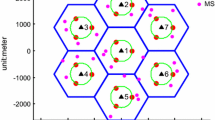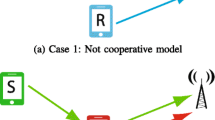Abstract
The increasing use of relays in wireless communication systems is a driving force to explore innovative techniques that can improve the quality of service as well as enhance the coverage in wireless systems. In this article, we propose a two-step approach for subcarrier allocation and power allocation in the downlink of an OFDM-based amplify-and forward relaying system. In the first step, the total power is allocated to mobile users and relays based on the optimum power ratio derived for the single-relay system. In the second step, subcarriers are assigned to the users based on cooperative subcarrier allocation algorithms. Compared to the non-cooperative algorithm with flat power allocation, the total throughput is shown to improve by applying the two-step cooperative subcarrier allocation and power allocation algorithms.











Similar content being viewed by others
References
Berezdivin, R., Breinig, R., & Topp, R. (2002). Next-generation wireless communications concepts and technologies. IEEE Communications Magazine, 40, 108–116.
Wahlqvist, M., et al. (1996). A conceptual study of OFDM-based multiple access schemes. Technical Report Tdoc 117/96, ETSI STC SMG2 meeting no 18, Helsinki, Finland.
Tarokh, V., Jafarkhani, H., & Calderbank, A. (1999). Space-time block coding for wireless communications: Performance results. IEEE Journal on Selected Areas in Communications, 17, 451–460.
Pabst, R., et al. (2004). Relay-based deployment concepts for wireless and mobile broadband radio. IEEE Communications Magazine, 42, 80–89.
Peter, S., & Heath, R. (2009). The future of wimax: Multihop relaying with IEEE 802.16j. IEEE Communications Magazine, 47, 104–111.
I. S.-. R. of IEEE Std 802.16-2004. (2009). IEEE standard for local and metropolitan area networks part 16: Air interface for broadband wireless access systems.
I. S. 802.16j-2009 (Amendment to IEEE Std 802.16-2009). (2009). IEEE standard for local and metropolitan area networks part 16: Air interface for broadband wireless access systems amendment 1: Multiple relay specification.
I. S. 802.16m-2011(Amendment to IEEE Std 802.16-2009). (2011). IEEE standard for local and metropolitan area networks part 16: Air interface for broadband wireless access systems amendment 3: Advanced air interface.
Soldani, D., & Dixit, S. (2008). Wireless relays for broadband access. IEEE Communications Magazine, 46, 58–66.
Kim, S., Wang, X., & Madihian, M. (2008). Optimal resource allocation in multi-hop ofdma wireless networks with cooperative relay. IEEE Transactions on Wireless Communications, 7, 1833–1838.
Hasan, Z., Hossain, E., & Bhargava, V. (2011). Resource allocation for multiuser OFDMA-based amplify-and-forward relay networks with selective relaying. In IEEE international conference on communications (pp. 1–6).
Duval, O., Hasan, Z., Hossain, E., Gagnon, F., & Bhargava, V. K. (2010). Subcarrier selection and power allocation for amplify-and-forward relaying over OFDM links. IEEE Transactions on Wireless Communications, 9, 1293–1297.
Kwak, R., & Cioffi, J. (2009). Fundamental power-allocation for cooperative relay networks. In IEEE communications conference (pp. 1–5).
Awad, M., & Shen, X. (2008). OFDMA based two-hop cooperative relay network resources allocation. In International conference on communications (pp. 4414–4418).
Shen, Z., Andrews, J. G., & Evans, B. L. (2005). Adaptive resource allocation in multiuser OFDM systems with proportional rate constraints. IEEE Transactions on Wireless Communications, 4, 2726–2737.
Nabar, R., Bolcskei, H., & Kneubuhler, F. (2004). Fading relay channels: Performance limits and space-time signal design. IEEE Journal on Selected Areas in communications, 22, 1099–1109.
Rasouli, H., & Anpalagan, A. (2010). SNR-based vs BER-based power allocation for an amplify-and-forward single-relay wireless systems with MRC at destination. In IEEE biennial symposium on communications.
Rasouli, H., & Anpalagan, A. (2011). An opportunistic subcarrier allocation algorithm based on cooperative coefficient for OFDM relaying systems. In IEEE wireless communications and mobile computing conference (pp. 178–183).
Anghel, P., & Kaveh, M. (2004). Exact symbol error probability of a cooperative network in a Rayleigh-fading environment. IEEE Transactions on Wireless Communications, 3, 1416–1421.
Jingmei, S., Qi, Z., Chunju, S., Ying, W., Zhang, Z., & Zhang, P. (2004). Adaptive optimal transmit power allocation for two-hop non-regenerative wireless relaying system. In IEEE vehicular technology conference (pp. 1213–1217).
Conne, C., & Kim, I. (2010). Outage probability of multi-hop amplify-and-forward relay systems. IEEE Transactions on Wireless Communications, 9, 1139–1149.
Rappaport, T. S. (2002). Wireless communications. Englewood Cliffs: Prentice Hall.
Proakis, J. G. (2002). Digital communications. New York: McGraw-Hill.
Rasouli, H., Sadr, S., & Anpalagan, A. (2008). A fair subcarrier allocation algorithm for cooperative multiuser OFDM systems with grouped users. In IEEE global communication conference.
Papoulis, A., & Pillai, S. (2002). Probablity, random variables, and stochastic processes. New York: Mc-Graw Hill.
Hasna, M. O., & Alouini, M.-S. (2004). Optimal power allocation for relayed transmissions over Rayleigh-fading channels. IEEE Transactions on Wireless Communications, 3, 1999–2004.
Fareed, M. M., & Uusal, M. (2008). BER-optimized powER allocation foR fading Relay channels. IEEE Transactions on Wireless Communications, 7, 2350–2359.
Jang, J., & Lee, K. B. (2003). Transmit power adaptation for multiuser OFDM systems. IEEE Journal on Selected Areas in Communications, 21, 171–178.
Rhee, W., & Cioffi, J. M. (2000). Increase in capacity of multiuser OFDM system using dynamic subchannel allocation, Vol. 2. In Proceedings IEEE international vehicular tehcnology conference (pp. 1085–1089).
Author information
Authors and Affiliations
Corresponding author
Rights and permissions
About this article
Cite this article
Rasouli, H., Kong, H.Y. & Anpalagan, A. Cooperative Subcarrier Allocation and Power Allocation in the Downlink of an Amplify-and-Forward OFDM Relaying System. Wireless Pers Commun 79, 2271–2290 (2014). https://doi.org/10.1007/s11277-014-1984-8
Published:
Issue Date:
DOI: https://doi.org/10.1007/s11277-014-1984-8




